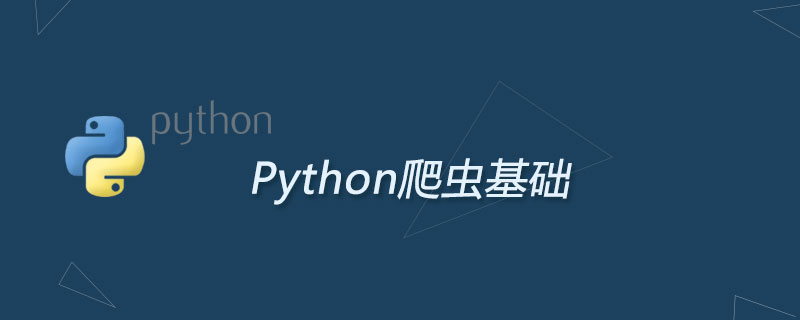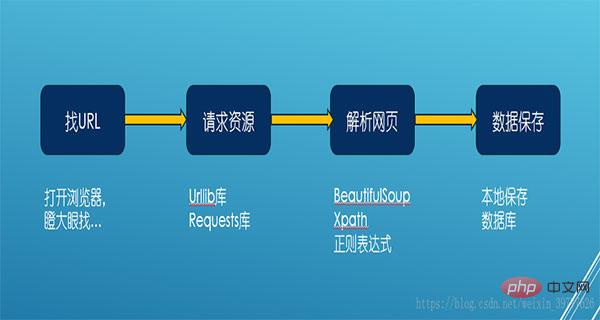What foundation is needed for python crawler
Starting with a crawler does not require you to be proficient in Python programming, but basic knowledge cannot be ignored. So what Python basics do we need? 
First of all, let’s take a look at the simplest crawler process:

The first step To Determine the link of the crawled page. Since we usually crawl more than one page of content, we should pay attention to the change of the link when the page is turned and the keyword changes. Sometimes we even need to consider the date; in addition, the main web page needs to be static, Dynamically loaded.
The second step Request resources, this is not difficult, mainly the use of Urllib and Request libraries, just read the official documents when necessary
The third step is to parse the web page. After the resource request is successful, the source code of the entire web page is returned. At this time, we need to locate and clean the data
When it comes to data, the first point to pay attention to is the type of data. Should you master it?
Secondly, the data on the web page is often arranged very neatly, thanks to the list. Most web page data is neat and regular, so do you need to master lists and loop statements too!
But it is worth noting that the web page data is not necessarily neat and regular. For example, the most common personal information, except for the required options, I don’t like to fill in other parts. At this time, some information is missing. You have to first determine whether there is data before crawling, so the judgment statement cannot be less!
After mastering the above content, our crawler can basically run, but in order to improve the code efficiency, we can use functions to divide a program into multiple small parts, each part is responsible for a part of the content, so that we can You need to mobilize a function multiple times. If you are more powerful and develop a crawler software in the future, do you need to master another class?
The fourth step is to save the data, is it necessary? First open the file, write data, and finally close it, so do you still need to master the reading and writing of files?
So, The most basic Python knowledge points you need to master are:

#So, if you want to learn crawling, you can get twice the result with half the effort only by mastering the above Python-related knowledge.
The above is the detailed content of What foundation is needed for python crawler. For more information, please follow other related articles on the PHP Chinese website!

Hot AI Tools

Undresser.AI Undress
AI-powered app for creating realistic nude photos

AI Clothes Remover
Online AI tool for removing clothes from photos.

Undress AI Tool
Undress images for free

Clothoff.io
AI clothes remover

AI Hentai Generator
Generate AI Hentai for free.

Hot Article

Hot Tools

Notepad++7.3.1
Easy-to-use and free code editor

SublimeText3 Chinese version
Chinese version, very easy to use

Zend Studio 13.0.1
Powerful PHP integrated development environment

Dreamweaver CS6
Visual web development tools

SublimeText3 Mac version
God-level code editing software (SublimeText3)

Hot Topics
 1385
1385
 52
52
 How to solve the permissions problem encountered when viewing Python version in Linux terminal?
Apr 01, 2025 pm 05:09 PM
How to solve the permissions problem encountered when viewing Python version in Linux terminal?
Apr 01, 2025 pm 05:09 PM
Solution to permission issues when viewing Python version in Linux terminal When you try to view Python version in Linux terminal, enter python...
 How to teach computer novice programming basics in project and problem-driven methods within 10 hours?
Apr 02, 2025 am 07:18 AM
How to teach computer novice programming basics in project and problem-driven methods within 10 hours?
Apr 02, 2025 am 07:18 AM
How to teach computer novice programming basics within 10 hours? If you only have 10 hours to teach computer novice some programming knowledge, what would you choose to teach...
 How to efficiently copy the entire column of one DataFrame into another DataFrame with different structures in Python?
Apr 01, 2025 pm 11:15 PM
How to efficiently copy the entire column of one DataFrame into another DataFrame with different structures in Python?
Apr 01, 2025 pm 11:15 PM
When using Python's pandas library, how to copy whole columns between two DataFrames with different structures is a common problem. Suppose we have two Dats...
 How to avoid being detected by the browser when using Fiddler Everywhere for man-in-the-middle reading?
Apr 02, 2025 am 07:15 AM
How to avoid being detected by the browser when using Fiddler Everywhere for man-in-the-middle reading?
Apr 02, 2025 am 07:15 AM
How to avoid being detected when using FiddlerEverywhere for man-in-the-middle readings When you use FiddlerEverywhere...
 What are regular expressions?
Mar 20, 2025 pm 06:25 PM
What are regular expressions?
Mar 20, 2025 pm 06:25 PM
Regular expressions are powerful tools for pattern matching and text manipulation in programming, enhancing efficiency in text processing across various applications.
 How does Uvicorn continuously listen for HTTP requests without serving_forever()?
Apr 01, 2025 pm 10:51 PM
How does Uvicorn continuously listen for HTTP requests without serving_forever()?
Apr 01, 2025 pm 10:51 PM
How does Uvicorn continuously listen for HTTP requests? Uvicorn is a lightweight web server based on ASGI. One of its core functions is to listen for HTTP requests and proceed...
 What are some popular Python libraries and their uses?
Mar 21, 2025 pm 06:46 PM
What are some popular Python libraries and their uses?
Mar 21, 2025 pm 06:46 PM
The article discusses popular Python libraries like NumPy, Pandas, Matplotlib, Scikit-learn, TensorFlow, Django, Flask, and Requests, detailing their uses in scientific computing, data analysis, visualization, machine learning, web development, and H
 How to dynamically create an object through a string and call its methods in Python?
Apr 01, 2025 pm 11:18 PM
How to dynamically create an object through a string and call its methods in Python?
Apr 01, 2025 pm 11:18 PM
In Python, how to dynamically create an object through a string and call its methods? This is a common programming requirement, especially if it needs to be configured or run...




